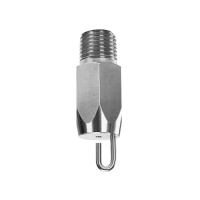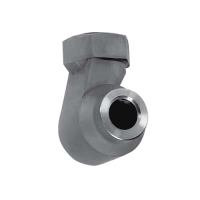BETE products are used in all aspects of the food industry, ranging from large-scale raw foods processing to the application of the shell on little chocolate candies. Our spray nozzle designs incorporate food-grade materials, connectors and spray patterns to meet clean-in-place requirements. Spray Nozzles play a critical role in maintaining a clean, safe and bacteria-free environment. Smoke houses and meat packers, for example, have reduced maintenance costs and increased process throughput with the efficient application of BETE spray nozzles. We also make products for reliable tank washing, sanitising, lubricating and spray drying during the packaging or bottling process.
Air inlet cooling nozzles
Many facilities or processes in hot, dry areas can benefit from using spray nozzles to cool the inlet air streams. Evaporating water into the inlet air can provide critical cooling of heat sensitive areas such as electronic server rooms or animal enclosures. It can also provide significant increases in efficiency of equipment such as gas turbines or air-cooled condensers by cooling the air and increasing the relative humidity level of the inlet air streams to these units.
Turbine inlet air cooling (TIAC) is common in dry areas that experience high temperatures either year round or seasonally to improve efficiency in power generation. During the summer, when demand for electricity is at its peak, the lower density of high temperature, dry air can reduce power generation up to 30% below rated capacity. Recapturing that lost efficiency can be achieved by increasing the air density through evaporative cooling. Use of the correct misting spray nozzles ensures complete evaporation of the droplets before contact with the turbine blades.
BETE misting nozzles are designed to work at high differential pressures in order to produce small drop sizes and increase cooling efficiency.
Common air inlet cooling nozzle uses and industries:
- Gas turbines
- Server rooms
- Air-cooled condensers
- Animal housing / enclosures
Product/deluge cooling nozzles
BETE provides a range of high-quality nozzles that are useful for reducing the temperature of various components and parts using a deluge spray. Many production processes require the product to be hot during work and then cooled back to ambient temperature. In metal processing industries, castings, extrusions, and hot-worked products fall into this category, as do any components that have been heat treated. In the food industry, many products are packaged hot and must be cooled before storage and shipment.
Cooling a solid object quickly is typically accomplished by deluging it with a coolant, most often water. The rate at which the object can be cooled with a water deluge depends on the shape of the object, initial temperature, final desired temperature, the heat capacity of the object, and the convection coefficient between the object and the water. Shape takes into account the surface area, volume, and indirectly the thermal conductivity of the object. It is also important to take into account that the object’s ability to transfer heat may not be uniform, as it may be made of several substances.
The principle idea is to distribute a high volume of water completely over the object, allowing the greatest contact and therefore heat transfer from the object to the water. Nozzle spray is advantageous because it can provide full coverage of virtually any object shape. Cooling takes time; the major advantage of spraying the coolant is the ability to speed up the process as compared to simple submersion. As the object cools down, the water in contact with the object heats up. In order to continue cooling, the warmed water should be flushed away to allow cooler water to contact the object. This flushing action is an inherent characteristic of the flood of liquid and spray dynamics produced by a spray nozzle.
Common cooling deluge nozzle uses and industries:
- Manufacturing industry
- Food processing industry
- Steel industry
- Cooling steel or aluminum strips
- Conveyor Cooling: cool cans, bottles, and jars after processing and pasteurisation
- Stationary Cooling: cool larger objects and components that are sitting still
- Extrusion Cooling: accelerate the cooling of extruded products such as wires, tubing, etc. as they travel through a dedicated cooling zone
- Complex Casting Cooling: evenly cool complex components / castings with varying wall thickness
Process gas cooling/quenching nozzles
BETE nozzles are used for quenching in commercial and industrial applications around the world. In many processes a gas is raised to temperatures that could easily damage downstream equipment. This can either be by direct combustion, as in the case of flue gas, or by secondary heating. The quickest and most effective way to cool a hot gas is through the evaporation of an injected liquid. Changing the phase of the injected liquid to gas consumes enormous amounts of energy compared to sensible/direct contact cooling.
In evaporative gas cooling, a mist of water is sprayed into the hot gas. In many cases this is flue gas from a combustion process. The water then evaporates, cooling the system rapidly as the energy is used to change the water from liquid to gas. When a volume of water is atomised into smaller droplets, more surface area is exposed, allowing the evaporation rate to increase. The rate of evaporation is often critical as the gas must reach its final temperature before a fixed point downstream. The evaporation rate is dependent on the droplet size, temperature differential, and partial pressure among other variables.
Common process gas cooling nozzle uses and industries:
- Cooling process gases prior to scrubber/bag-houses
- Cooling combustion exhaust gases
- FGD quench systems
- Emergency quench systems
Pond cooling nozzles
Cooling ponds are used to lower water temperature through contact cooling with the surrounding air. Static ponds often have low cooling efficiency and require a lot of space as only the surface of the pond is in direct contact with the air, resulting in relatively expensive use of valuable land. BETE offers a wide variety of spray nozzles which can dramatically lower the expense and footprint of cooling ponds. By spraying and atomising the water from the cooling ponds into the air, spray nozzles significantly increase the surface area of water exposed to the air, thus improving the cooling efficiency and decreasing the area needed for the pond. In some cases the use of spray nozzles can reduce the land required to 5% of the area needed for a static pond.
Common pond cooling nozzle uses and industries:
- Mining industry
- Steel industry
- Utilities/power generation industry
- Pulp and paper industry
- Agricultural processing
- Chemical processing industry
- Increase efficiency of static cooling ponds













